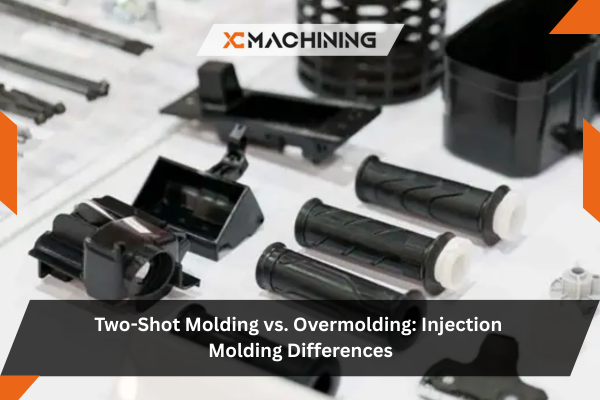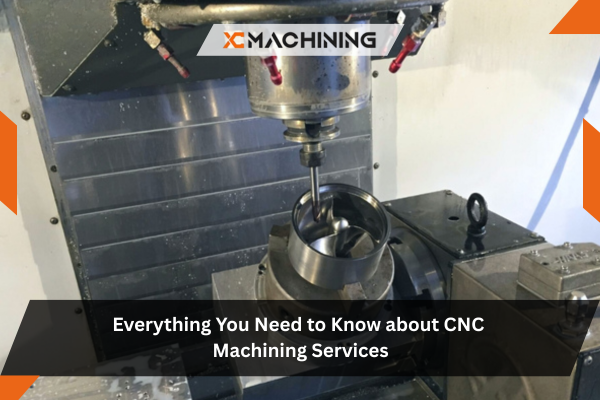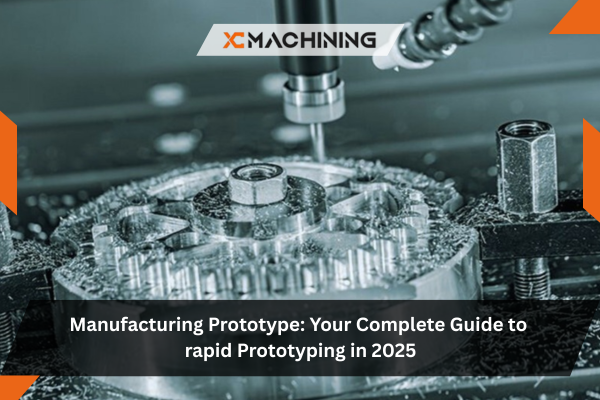Choosing between two-shot molding and overmolding significantly impacts production costs and product quality. Both molding techniques fall under the umbrella of injection molding, yet each manufacturing process serves different needs. After completing over 500 multi-material projects at XC Machining, patterns emerge showing which process works best for specific applications.
The plastic injection molding industry reached $519.1 billion in shipments during 2024 according to the Plastics Industry Association. Understanding injection molding vs overmolding helps manufacturers avoid costly mistakes. The two processes are similar in concept but differ dramatically in execution and economics.
What Makes Two-Shot Injection Molding Different?
Two-shot injection molding is a specialized molding technique that combines two different materials through sequential injection within the same molding cycle. Our facility has produced automotive components using this method since 2015, giving real insight into performance under production conditions.
The Technical Process Behind Two-Shot Molding
The process involves injecting two materials using injection molding machines with two or more injection units. The first shot creates the substrate, then the mold rotates 180 degrees. The second material is injected directly onto the first, creating molecular bonding. This multi-shot injection molding process eliminates assembly completely.
Temperature control becomes critical in the two-shot injection molding process. Both materials must reach melt temperatures within 20°C of each other. Last month, testing ABS at 240°C with TPU at 220°C produced perfect bonds on 2,000 medical device handles without delamination.
The molding cycle runs 35-55 seconds for most parts. That beats making two separate parts through traditional injection molding and assembling them, which takes 90+ seconds total. The molding operation happens in one machine with no handling between steps.
Cómo funciona el sobremoldeo
Overmolding involves creating the substrate first using standard injection molding, then placing it into a second mold where the second material is injected around it. This subcategory of injection molding offers flexibility that two-shot processes cannot provide.
Material Flexibility in the Overmolding Process
The versatility of overmolding shows up when combining incompatible materials. Last quarter, a client needed silicone overmolded onto stainless steel fasteners. Two-shot molding cannot handle this combination, but the overmolding process handled it easily through insert molding techniques.
Use any standard injection molding machine for overmolding. The main requirement involves designing molds that securely hold the substrate during the second injection. XC Machining runs overmolding operations on equipment that also handles single molding projects, keeping costs manageable for clients needing 800-5,000 units.
Testing different molding materials reveals which combinations bond reliably. Polycarbonate substrates with TPE overmolds create strong mechanical bonds through 0.5mm undercuts. Surface preparation matters—light bead blasting increases bond strength by roughly 30% versus smooth surfaces.
Key Differences Between Overmolding vs Two Shot Molding
Comprender Two shot moldeo por inyección and overmolding differences requires examining how each molding process performs in actual production. Working with both processes simultaneously for years reveals clear patterns.
The molding equipment represents the first major difference. Two-shot plastic injection molding requires specialized equipment with dual barrels and precision rotation systems running $180,000-$450,000. Whereas sobremoldeo uses standard machines typically costing $65,000-$140,000.
| Característica | Two-Shot Molding | Sobremoldeado |
| Equipment | Specialized dual-barrel | Standard injection molding machine |
| Duración del ciclo | 35-60 seconds | 65-110 seconds |
| Material Bond | Molecular (10 MPa) | Mechanical/chemical (4-8 MPa) |
| Volume Sweet Spot | 10,000+ units | 500-5,000 units |
| Coste de utillaje | $22,000-$95,000 | $12,000-$48,000 |
Material bonding strength differs significantly. Two-shot molding involves injecting two different materials that fuse molecularly, testing at 10 MPa. Overmolding provides mechanical bonds around 4-8 MPa depending on substrate preparation. Both exceed requirements for most applications.
Production Economics Comparison
An injection molding quote shows how volume affects costs. For 2,500 tool handles, overmolding cost $4.80 per unit versus $8.20 using two-shot molding. At 25,000 units, two-shot dropped to $2.10 per part while overmolding stayed around $4.40. Break-even occurs around 9,000-11,000 units for typical products.
Advantages of Two-Shot Injection Molding

Two-shot molding offers distinct benefits when production requirements align with its capabilities. Real projects reveal where this injection molding process is best.
Stronger Bonds and Quality
Chemical bonding between two materials creates parts withstanding stress testing better than mechanically bonded alternatives. Testing 500 automotive gear shifters produced through 2-shot injection molding showed zero delamination after 50,000 cycles. Similar parts made through assembly with adhesives failed around 12,000 cycles.
Production Speed for Volume
One injection operation creates complete parts without secondary operations. A recent project producing 45,000 medical device housings demonstrated efficiency. Two-shot molding allows engineers to complete parts in 42 seconds each. Manual assembly would have taken 85 seconds plus inspection time, requiring three workers versus one operator.
Design Freedom with Dual-Shot Molding
Engineers gain freedom combining hard and soft materials precisely where needed. Gaming controllers use rigid ABS for structure and soft TPE for grips. The molding technique allows 0.1mm precision in material boundaries—impossible with overmolding. Two-shot molding offers permanent color integration that won’t wear off through years of use.
Advantages of Overmolding
Overmolding provides practical solutions when project requirements favor flexibility over speed. Working with clients across industries shows where this process delivers best results.
Lower Initial Investment
Using standard injection molding equipment means smaller manufacturers can produce multi-material parts without major capital investment. One startup client needed 1,200 tool handles. Overmolding is best suitable for this volume, requiring only $18,500 in tooling versus $72,000 for two-shot molds.
Material Combinations Beyond Two-Shot
Overmolding involves combining materials impossible for two-shot methods. Recently completed project required liquid silicone rubber overmolded onto aluminum inserts. Two-shot equipment cannot combine two materials with 200°C temperature differences. Overmolding and two-shot injection molding each serve different material needs.
Creación rápida de prototipos
Product development speeds up using overmolding for testing. Engineers CNC machine substrate prototypes, then overmold different materials to test performance. This approach produced functional prototypes in 5 days versus 6 weeks for specialized molding tooling. Overmolding provides designers flexibility during development.
Common Applications and Industry Use
Real-world applications demonstrate how injection molding and overmolding serve different market needs. Client projects reveal industry preferences.
Two-Shot Molding Applications
Automotive components represent the largest application. Interior trim pieces combine structural rigidity with soft-touch surfaces. One ongoing project produces 8,000 monthly door panel inserts using this process that involves injecting two different materials in precise locations.
Medical devices requiring high volumes use two-shot injection molding. Current project manufactures 120,000 monthly retractor handles combining rigid polysulfone with soft TPE grips. The process creates end product from two materials that meets surgical instrument durability standards.
Overmolding for Tools and Devices
Tool manufacturers favor overmolding for comfort grips. Production volumes typically range 2,000-6,000 units per model—perfect for overmolding economics. Recently completed screwdriver project produced 4,500 units with fiberglass-reinforced nylon handles and TPE overmolded grips using sequential injection methods.
Consumer electronics in smaller quantities rely on overmolding. One tablet stylus project produced 7,000 units using aluminum substrates with TPE overmolded grip zones. Overmolding material selection allowed anti-static properties needed for electronic applications.
Material Selection Considerations

Choosing compatible molding materials determines project success. Testing hundreds of combinations revealed which pairings work reliably. Two plastic materials in two-shot molding must meet thermal compatibility requirements. Processing temperatures need falling within 15-25°C for optimal bonding in the two-shot injection molding process.
Shore hardness differences typically range 35-65 points. Testing showed 40 Shore A difference produces optimal results for handheld products. Too little contrast means soft material doesn’t provide intended grip.
The first shot cooling time impacts second material bonding in the molding process. Optimal timing varies—thin walls need 8-12 seconds, thick sections require 18-28 seconds before second injection occurs. Getting this right prevents deformation and ensures proper bonding.
Cost Analysis for Production Volumes
Getting accurate cost estimates requires understanding volume economics. For 1,500-unit runs, overmolding typically costs $5.20-$9.80 per part. Two-shot molding runs $9.50-$16.20 at this volume because specialized equipment carries higher rates and tooling hasn’t amortized.
At 8,000 units, costs converge. At 30,000 units, two-shot molding quoted $2.90 each ($87,000) while overmolding was $4.80 each ($144,000)—saving $57,000. The faster molding cycle and single molding operation offset higher initial investment at volume.
Quality inspection requirements differ too. Two-shot parts rarely need bond testing since molecular bonding proves consistent. Overmolded parts benefit from periodic peel testing, adding $0.15-$0.30 per part for critical applications.
Making the Right Choice
Selecting between two-shot molding vs overmolding depends on multiple factors. After guiding 300+ clients through this decision, clear patterns emerge.
Production volume drives economics most. Parts needed under 7,000 units favor overmolding unless special circumstances apply. Volumes exceeding 12,000 units typically justify two-shot molding investment. Between these ranges requires detailed analysis.
Part geometry influences selection significantly. Products requiring sharp material boundaries or multiple material zones work better with two-shot technology—achieving 0.08mm precision. Overmolding typically achieves 0.3-0.5mm boundary precision.
When combining two or more different thermoplastics with similar temperatures, either works. However, metal substrates or incompatible materials force overmolding selection. Overmolding may combine materials with 200°C temperature differences that two-shot equipment cannot handle.
Industry Trends and Future Outlook
The injection molding is a popular manufacturing technique showing resilience despite challenges. According to the U.S. Bureau of Labor Statistics, plastics and rubber products manufacturing employed 589,542 workers in December 2024—a 0.9% decline from 2023. However, productivity improvements through automation compensate for workforce reductions.
Automation particularly benefits both processes. Robotic substrate handling systems installed at XC Machining increased throughput 18% while reducing defects 34%. These systems position parts with 0.02mm repeatability.
Recycled content increasingly appears in injection molding services. Testing post-consumer recycled ABS showed bond strengths within 3% of virgin material. Clients now specify 25-30% recycled content meeting sustainability goals without compromising quality created by the injection molding process.
Smart manufacturing transforms monitoring. Real-time sensors track the mold chamber and injection molding nozzle parameters for every cycle. Recent installation caught nozzle temperature drift within 8 parts, preventing 2,400 defective parts and saving $18,000.
Conclusión
Choosing between overmolding vs two shot molding depends on production volume, material requirements, and budget constraints. Two-shot molding excels for high volumes exceeding 10,000 units where speed and molecular bonding matter most. Overmolding depends on several factors but provides cost-effective flexibility for smaller runs.
XC Machining brings 15+ years experience in both the injection molding process that produces multi-material parts. With ISO 9001:2015 certification and 500+ completed projects, the engineering team provides accurate analysis. Whether producing 500 prototypes or 50,000 production units, proper process selection ensures quality results and optimal economics.
Preguntas frecuentes
What is the main difference between overmolding and two-shot molding?
Two-shot molding combines two materials in one automated cycle using specialized dual-barrel machines, creating molecular bonds. Overmolding requires two separate molding operations where substrate gets made first, then placed in a second mold for overmold material injection.
Which process costs less for small production runs?
Overmolding costs 40-50% less for volumes under 8,000 units due to lower tooling ($12,000-$48,000) and standard equipment use. Two-shot molding becomes economical above 10,000 units where faster cycles offset higher investment.
Can both processes use the same materials?
Two-shot molding requires thermally compatible plastics with melt temperatures within 15-25°C. Overmolding handles broader combinations including metal substrates and thermally incompatible materials through mechanical bonding.
How long does each process take per part?
Two-shot molding cycles run 35-60 seconds producing finished parts directly. Overmolding takes 65-110 seconds total including substrate transfer time between molds.
Which industries use these processes most?
Automotive and consumer electronics dominate two-shot molding for high-volume production. Hand tools, medical devices, and industrial equipment favor overmolding for smaller batches and material flexibility.
References
- U.S. Bureau of Labor Statistics. (2024). “Plastics and Rubber Products Manufacturing: NAICS 326.” Retrieved from https://www.bls.gov/iag/tgs/iag326.htm
- Plastics Industry Association. (2024). “The U.S. Plastics Industry in 2024: Seven Key Charts.” Retrieved from https://www.plasticsindustry.org/
- Society of Plastics Engineers. (2024). “Injection Molding Division Technical Resources.” Retrieved from https://www.4spe.org/
- Federal Reserve Bank of St. Louis. (2024). “Unit Labor Costs for Manufacturing: Plastics and Rubber Products.” FRED Economic Data. Retrieved from https://fred.stlouisfed.org/series/IPUEN326U101000000
- U.S. Bureau of Labor Statistics. (2024). “Metal and Plastic Machine Workers: Occupational Outlook Handbook.” Retrieved from https://www.bls.gov/ooh/production/metal-and-plastic-machine-workers.htm





